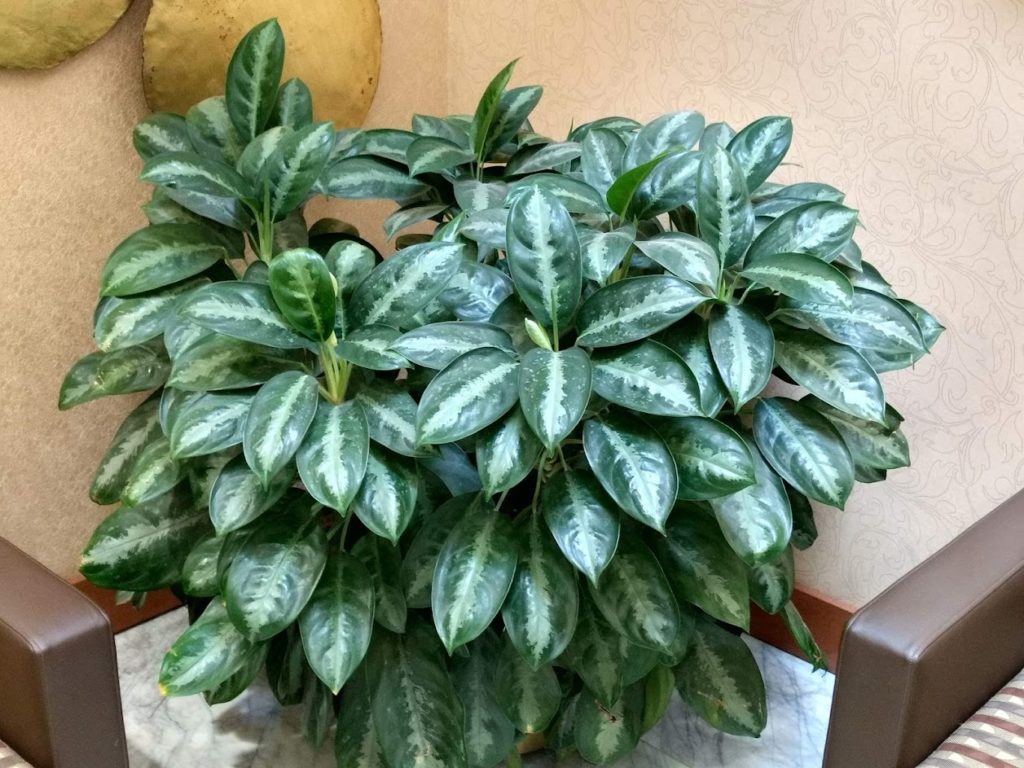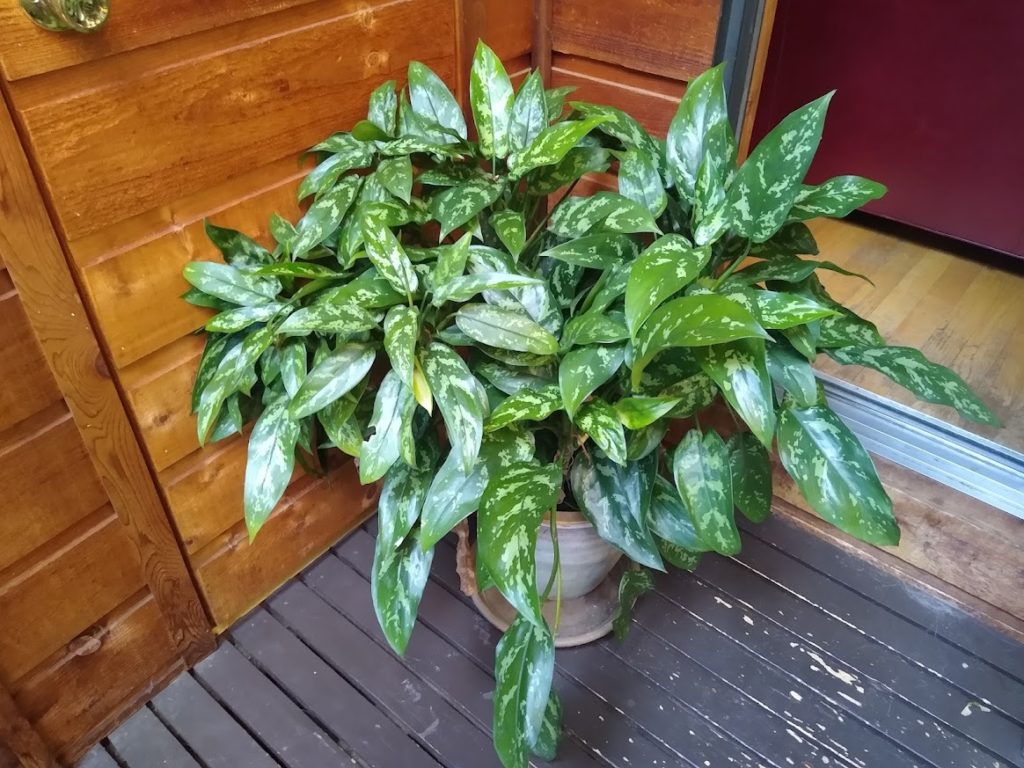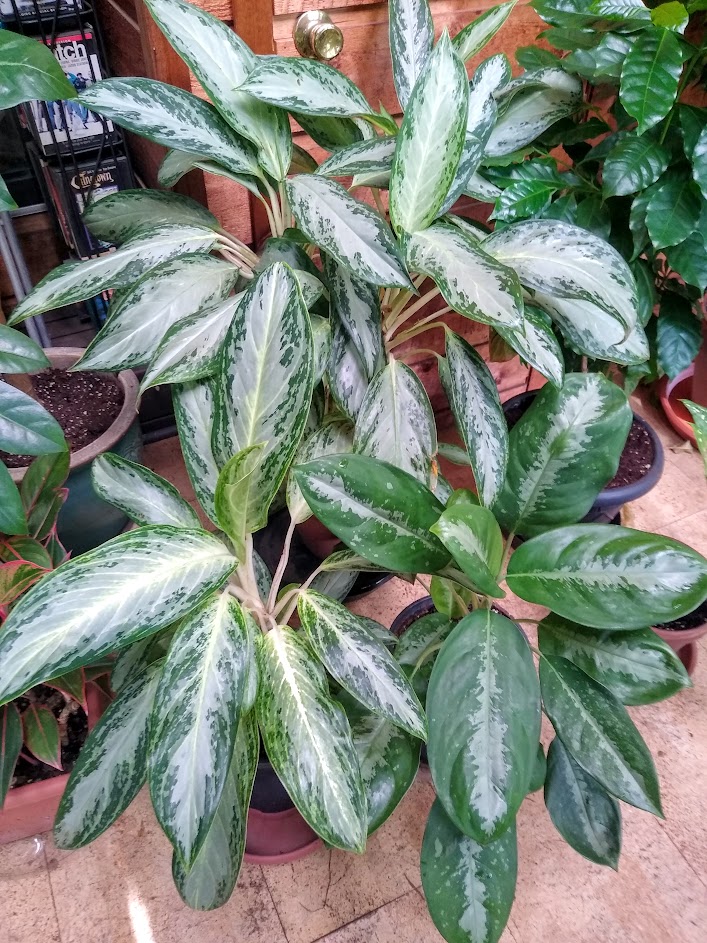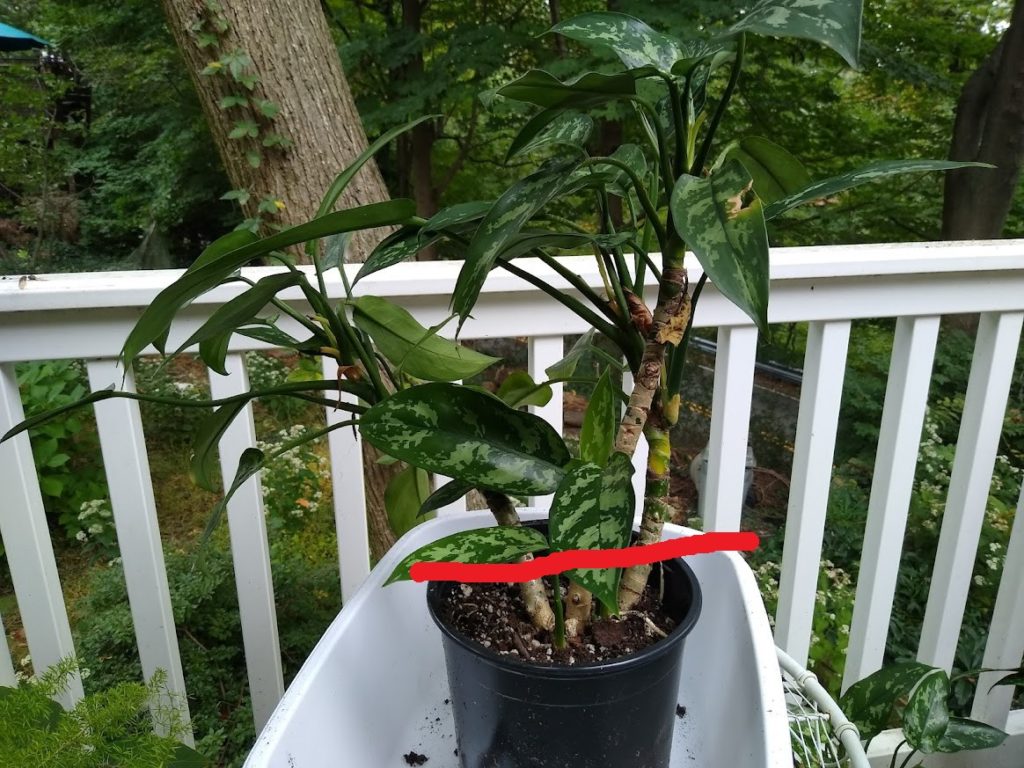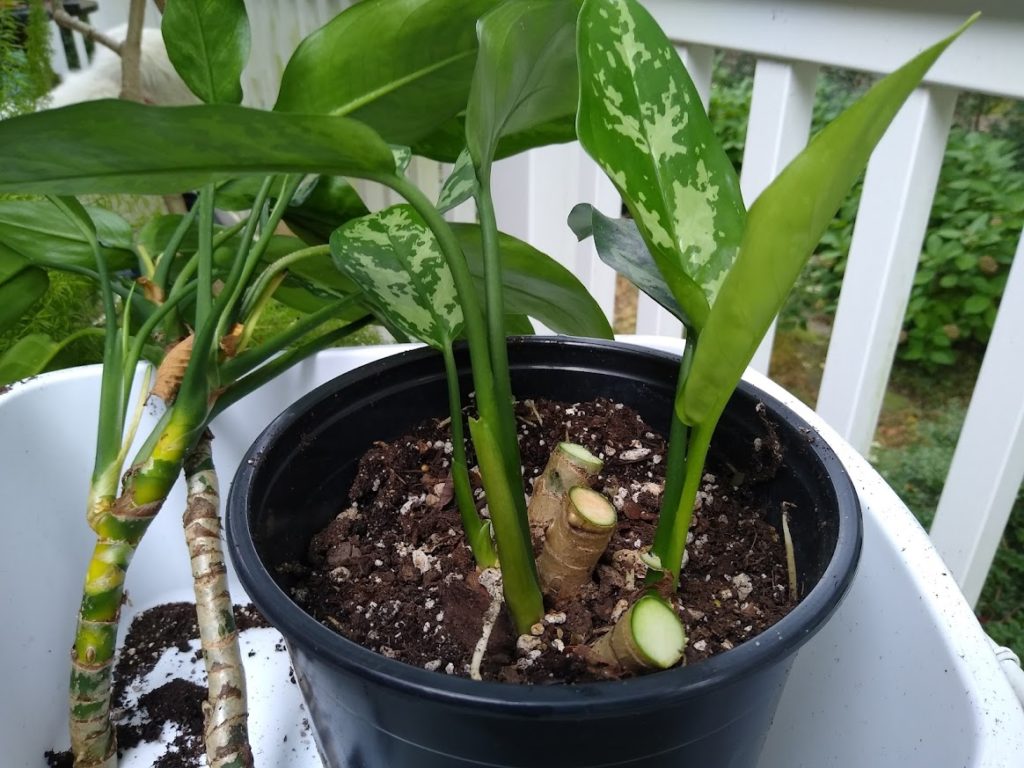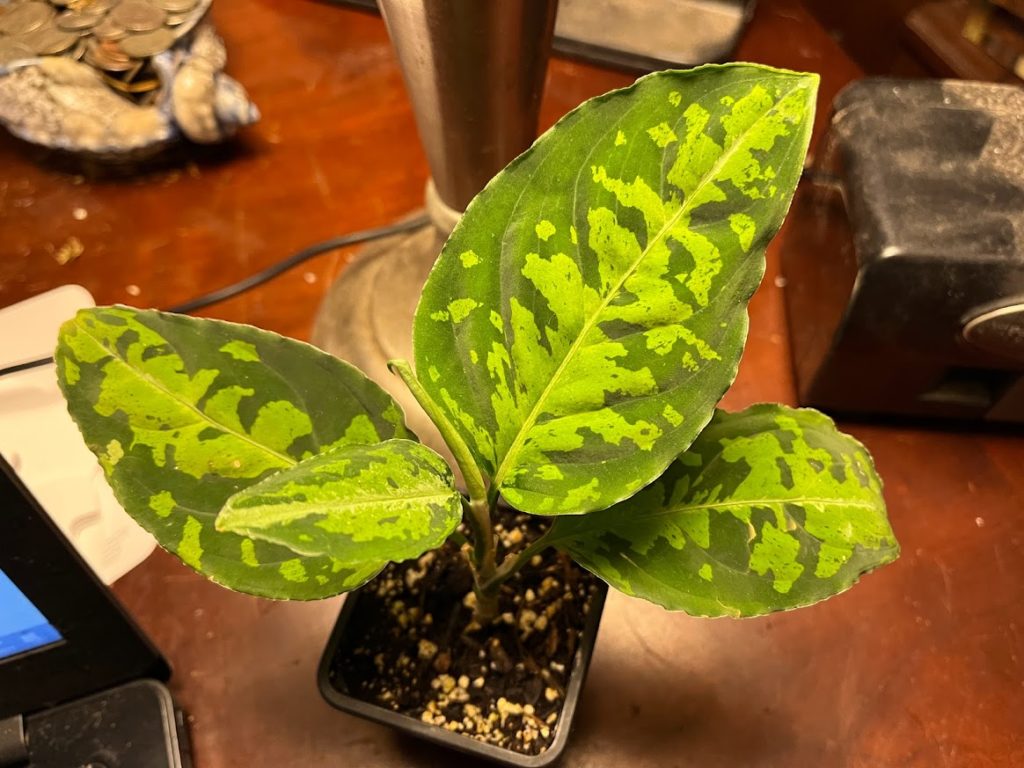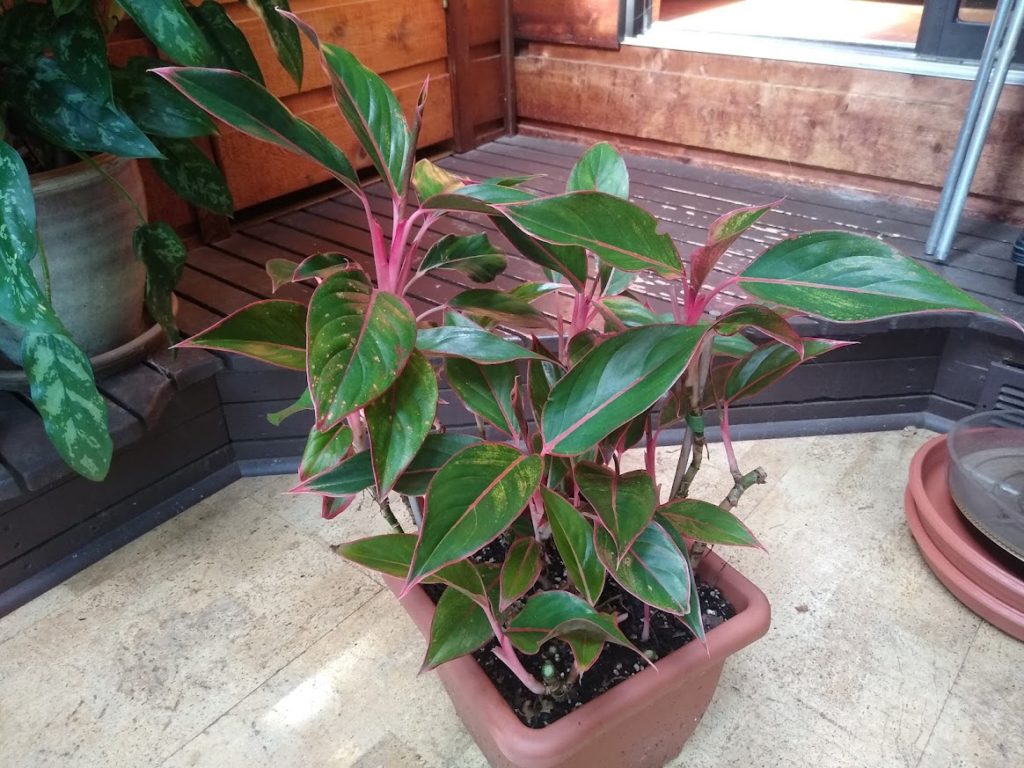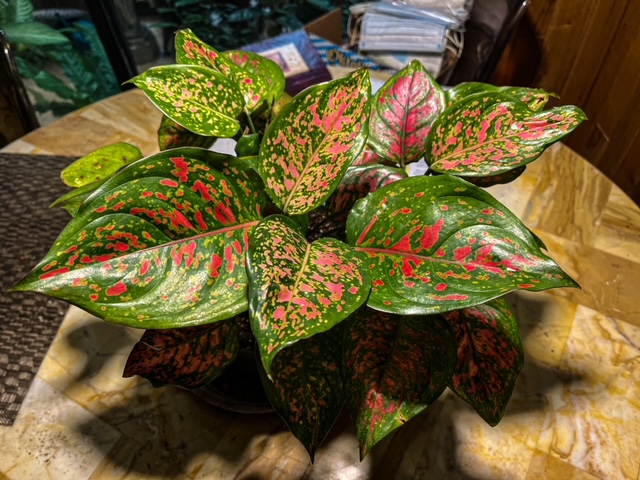
The care of Aglaonemas is quite simple: provide low to moderate light levels, keep the temperature at or above 60 F and water when the top 1/2″ of soil is dry. However, as I wrote previously, there are really two classes of Aglaonema: the old and the new. Aglaonema care of the older varieties is much different from that of the newer, more colorful varieties you’ve likely come across on Instagram. So, to keep you’re Aglaonema happy and healthy, you should first identify whether you have an ‘old’ or ‘new’ variety.
I will guide you through this, dear reader:
Above is a gallery of older, tougher easy care Ags from the authors collection. In general they become tall, thick stemmed plants and are mostly various shades of green and white. Varieties like ‘Maria,’ ‘Silver Queen,’ and ‘Silver Bay’ are commonly found in box stores and most nurseries (Maria center, Silver Bay on right). They require little light, tolerate low temperatures and aren’t that particular about soil moisture.
Older Aglaonema varieties also have a specific growth habit that varies greatly from their newer counterparts. Their stems are thick and rarely require staking for support. They can also grow quite tall and bushy if grown in a large container and amply fertilized. Plants with stems over 2ft tall are not uncommon and they can easily fill out a 12″ container.
Aglaonema Care: Old varieties:
- Light: They thrive in low light and are the perfect plant to occupy a shady corner. 50-100 foot candles is sufficient for maintenance.
- Temperature: Healthy, mature specimens can weather lower temperatures. The author’s are sometimes subjected to 45 F on cold winter evenings. If exposed to cooler temperatures, the soil needs to dry down several inches and they must be kept out of the wind and pouring rain.
- Humidity: More tolerant of lower humidity than most tropical houseplants.
- Watering: Most will tolerate over-watering or underwatering. Don’t allow them to dry down all the way or sit in a saucer full of water. In most instances, your tap water should be fine.
- Potting soil: Old variety Aglaonemas have strong, fleshy roots (see below). Therefore, almost any good quality peat and-perlite based potting soils will work straight from the bag. If you have a tendency to overwater plants, adding additional perlite, orchid bark, or coconut coir to the mix will be beneficial.
- Potting: I will provide you with a PRO-TIP Aglaonemas always do better in plastic pots than in unglazed clay pots. Clay pots retard their growth severely once the container is full of roots.
- Fertilizer: I prefer to fertilize my old-variety Aglaonemas fairly heavily during the summer. Choose a water soluble fertilizer that has roughly equivalent levels of nitrogen and potassium (the first and third numbers on the fertilizer bottle). I rotate through many fertilizers, but would recommend using either 20-20-20 or 20-10-20 analyses. One quarter teaspoon (1.25ml) per gallon once per week in the summer is a safe rate. Water only with unfertilized water once a while to avoid fertilizer salt buildup. Adding a half teaspoon of epsom salts (magnesium sulfate) two or three times per year is advised since they have a high magnesium requirement. I don’t recommend using slow release fertilizers (like Osmocote) on Aglaonemas.
Additional information for old varieties
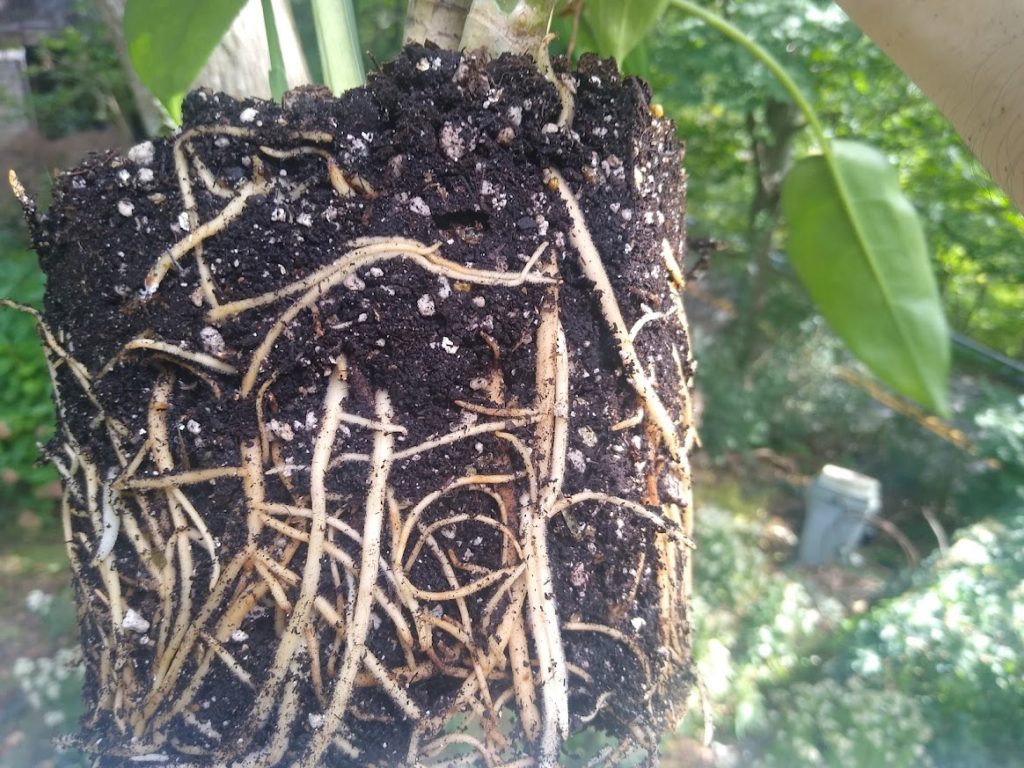
Roots
As shown above, old variety Aglaonemas have thick, fleshy roots. Many care guides advise that you allow Aglaonemas to dry out well before watering. In my experience, old Aglaonemas are tolerant of heavier watering and on mature old plants, underwatering will cause the lower leaves to yellow and fall. Think about it: in nature, aglaonemas are endemic to swampy areas and are likely adapted to having lots of moisture around their root systems at all times.
Pruning
Aglaonemas don’t require pruning for maintenance. In most cases, you’ll simply have to remove the lower, shriveled leaves to keep your pant looking tidy. However, in some instances you may wish to give your plant a drastic makeover, and options are available to you.
If some malady should befall your aglaonema, be a pest infestation or sun scorch, you should employ what I call the nuclear option. The nuclear option is simply cutting back the tall stems as shown in the upper left photo. New shoots will develop laterally and if conditions favorable, the plant will fill admirably in a few months.
Outdoor Aglaonema Care
In the summer months, your aglaonema will benefit from being placed outdoors. However there’s one condition: never, ever expose them to direct sunlight! If placed in direct sun for even an hour, your plant’s leaves will scorch terribly and the colors will bleach out. Once daytime temperatures reach 80F feel free to fertilize your plant with a balanced fertilized at 1/4 the recommended rate. Fertilizers containing urea nitrogen are beneficial during warm weather and remember to give them a little epsom salt from time to time as well.
Feel free to leave your old Aglaonemas in a shaded position until night temperatures drop below 55F and daytime temperatures rarely exceed 70F. I live in zone 7B and bring my old variety Aglaonemas inside during the first or second week of October. For their last watering outside, I flush them out with with a large volume of plain tap-water to remove the residual fertilizer salts in the potting soil. Inexperienced keepers should err on the side of caution and leave them out no longer than the last week of September.
Winter Aglaonema Care
As mentioned previously, old aglaonema varieties can tolerate night temperatures in the upper forties if they’re large, healthy and kept inside. Situate them away from vents, heaters, fireplaces, and drafty windows. Let the soil dry down several inches before giving your plant a small amount of water: enough to wet the surface of the soil, but not enough to run out of the pot. On sunny days you can spritz the plant with warm water to give it a little humidity. Plants grown in sphagnum peat rich potting mixes seem to tolerate cold winter conditions better than those in lighter soils. I believe this is because peat provides better insulation to the roots than other common potting materials.
Pest and Disease Control
Don’t despair if your hardy Aglaonema has pest issues: these plants don’t succumb to infestation easily and can be saved with simple techniques. My own plants have only had light cases of scale in the late winter, when temperatures and humidity were very low. Frequent spraying of neem oil at the rate of 2 TBSP/gallon (30 ml/liter) and a drop of dish soap will clear them away.
When I did indoor plant care professionally and worked at a nursery, mealybug was a frequent issue (along with scale). This arose because our plants were kept in far too much light in the greenhouse (only 50% shade cloth). The same rate of neem oil will work on mealybugs but you’ll have to be more diligent in the case of a heavy infestation, as mealybugs reside on the entire plant above the soil line (not just leaf leaf surfaces like scale).
For mealybugs located on your plants’ stems, take a q-tip and soak it in a bit of liquid dish soap. Then smother and wipe away the mealybugs one by one. Change q-tips frequently. This technique can leave ugly splotches on leaf surfaces.
To rid your plant of mealybugs located on the leaves use the recommended neem oil solution above (it’s organic and harmless to humans, although it can irritate people with really bad allergies.) Set your sprayer to the strongest stream setting and try to shoot each mealy bug with a forceful jet of water.
I have never experienced a disease issue on Aglaonemas although bacterial rot can be a problem.
Propagation
I have already written an extensive article about propagating aglaonemas from cuttings. Seed propagation is impractical for the vast majority of growers.
Aglaonema Care: New Varieties
The new varieties of Aglaonema have beautiful, bright colors and thin stems. You’ve likely come across several of them on Instagram. Popular varieties include ‘Red Valentine,’ ‘Pictum Tricolor’, ‘Prince Siam,’ ‘Lady Valentine,’ Lucky Red,’ etc. They’re far more expensive than the older varieties and their care is more exacting: they require higher light, warmer temperatures, more careful watering, and succumb to bacterial diseases.
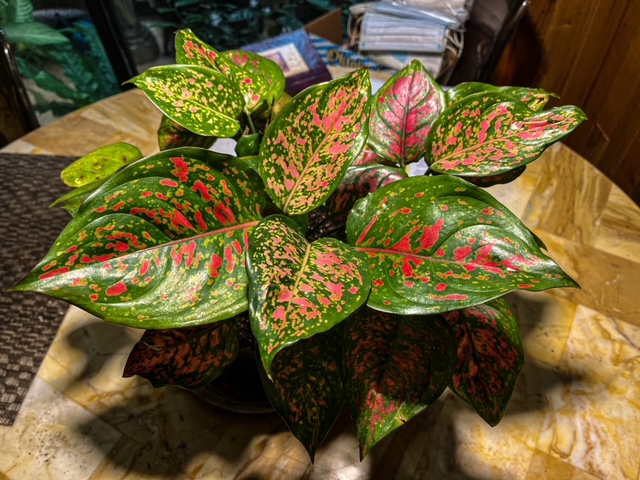
Aglaonema care for new varieties:
- Light: Although tolerant of lower light, to keep their colorful leaves looking bright and colorful you must give them at least 400 foot candles throughout the day. An east or west window or artificial light will be excellent.
- Temperature: These Aglaonemas do not like prolonged exposure to temperatures below 55 F, particularly when they are small.
- Humidity: Humidity isn’t much of an issue for new Aglaonema varieties either.
- Watering: New Ags don’t have the robust root system of their older counterparts and are not nearly as tolerant of over watering. Don’t water until at least the top 20% of the soil is dry to the touch.
- Potting soil: Given their relatively puny root system, be sure to incorporate some bark or coconut husk chips into a peat/perlite mix to improve drainage and aeration. They grow well in straight coconut husk chips (Note that coconut husk chips are not the same thing as coco coir).
- Potting: Be careful not to overpot new varieties. They are much smaller and slower growing than the old varieties and it will take them quite a long time to fill an 8″ diameter pot. I prefer plastic pots for new varieties as well.
- Fertilizer: Newer varieties do not require much fertilizer. Try using a fertilizer that is high in phosphate and contains ample chelated iron (Fe). If your plant lacks iron, it’s red coloring will likely fade. Incorporating a small amount of epsom salt a few times a year is still a good idea.
- Staking: New Ags have thin stems and staking the taller sections of your plant will be necessary if you want it to maintain a tidy appearance. Bamboo stakes affixed with velcro tape work well.
- Pests: Scale can be an issue on new Ags, particularly in winter. Using the methods described above to eliminate them.
- Disease: In my opinion, disease issues are much more prevalent in the new group. Brown leaf spots caused by the fungi Myrothecium and Colletotrichum can arise from time to time throughout the year. Spray affected pants with Daconil or a solution of baking soda and water. Stem rot is caused by fusarium. The best remedy is to cut out the rotten parts of your plant and replant it into a fresh, better draining potting medium.
Summation of Aglaonema Care
I’ve tried to make it explicit that the care of old and new Aglaonemas is very different and to reiterate, the key to success is knowing whether you have a new or old variety! In either case, Aglaonemas are wonderful plants and have a place in every houseplant collection.
